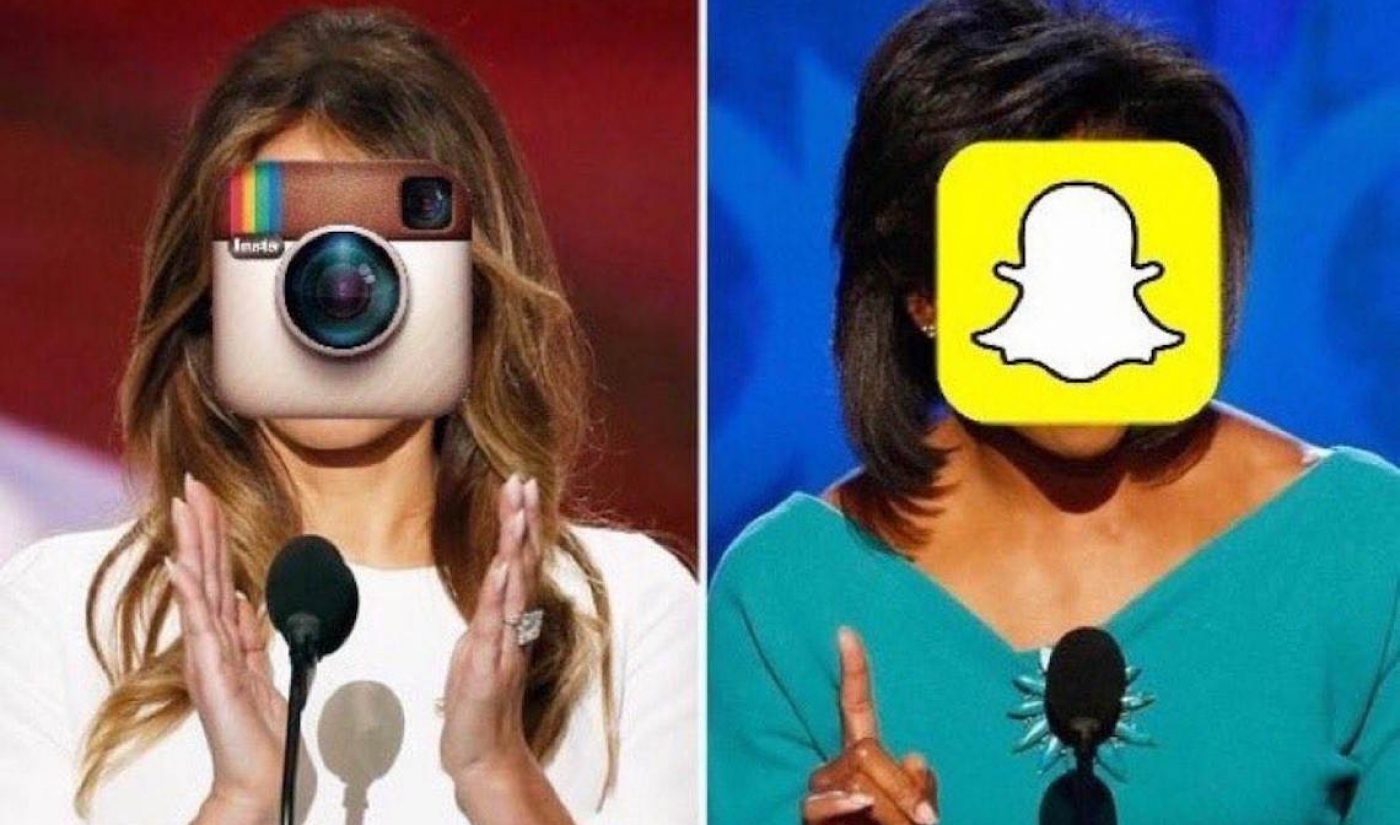Insights is a new weekly series featuring entertainment industry veteran David Bloom. It represents an experiment of sorts in digital-age journalism and audience engagement with a focus on the intersection of entertainment and technology, an area that David has written about and thought about and been part of in various career incarnations for much of the past 25 years. David welcomes your thoughts, perspectives, calumnies, and kudos at david@tubefilter.com, or on Twitter @DavidBloom.
This installment of Insights is brought to you by Beachfront RISE. 
The recent rollout of Instagram Stories, a straight rip of the basic Snapchat experience of throwaway content, has launched a thousand complicated responses among influencers, brands, users and others, making it a veritable Helen of Troy of social-media controversy.

Subscribe to get the latest creator news
Instagram’s offering joins a long, if not quite honorable, tech tradition: If someone else is doing it better than you, buy ‘em. If they don’t want to sell, copy ‘em, then fight it out in the courts years later. It’s played out like this for decades:
- Hollywood. Yes, 350 days of light a year was a powerful incentive for filmmakers to come west. But so was space, as in 3,000 miles across the country from Thomas Edison’s New York-based patent enforcers.
- Television. Both Philo T. Farnsworth and RCA’s David Sarnoff realized that capturing and transmitting images across the airwaves at scale required an all-electronic technology, not the electro-mechanical methods of previous attempts. Farnsworth figured out the technology, but not Sarnoff’s guy, Vladimir Zworykin, at least not until Zworykin visited Farnsworth’s lab. The resulting RCA alternative undergirded a new industry, slighting credit to Farnsworth, who at least eventually won what was then a massive $1 million payout in court.
- Microsoft Windows. First, Apple’s Steve Jobs visited Xerox’s PARC research facilities, seeing prototypes for such computing fundamentals as the mouse and the graphical user interface. He and Woz built the Mac. Microsoft, in a privileged position as the provider of DOS, the operating system that ran all those IBM desktop computers in companies across America, in turn created Windows, a very close copy of much of the PARC/Mac interface. Epic lawsuits ensued, to little satisfaction for Apple. Microsoft Windows dominated the 1990s.
- Smartphones. Tech companies have become increasingly sophisticated about patenting even minor innovations, and suing about it all. In fact, one big reason for Google’s messy Motorola acquisition was its bank of patents. Over the past decade, the infringement lawsuits have multiplied, nowhere more so than between Apple and a fleet of Android phone makers led by Samsung.
Companies often have tried to buy even highly valued companies rather than build/copy. Microsoft famously made a run at Facebook when the company was just emerging, but Mark Zuckerberg said no. In turn, Facebook acquired, yes, Instagram, Oculus Rift, and WhatsApp for billions each. Google’s biggest purchase, strategically, was YouTube, which since has built an entire digital-media ecosystem. And Amazon grabbed Twitch for nearly $1 billion two years ago, scooping it up when Google couldn’t make a deal (afterward Google launched the copycat Youtube.Gaming).
Buying doesn’t always work out, of course. Look at Microsoft’s disastrous Nokia foray. I’m holding fire for now on Redmond’s Mojang and LinkedIn acquisitions, though Microsoft recently considered buying Slack for $8 billion before CEO Satya Nadella killed the deal. Nadella suggested the money could be better spent on improving another of the company’s expensive acquisitions, Skype. Long-suffering Skype users should celebrate, though Slackers may not.
And Disney has had several digital underachievers where it bought rather than built/copied, including Go.com, Maker Studios, Disney Infinity, and Disney Interactive (which just had another round of layoffs).
But here’s the thing: copying actually can be good for users.
Arguably, we’re building the navigation and hand-gesture equivalent of film and TV’s visual vocabulary, which was created by groundbreakers such as Sergei Eisenstein and Orson Welles in the first half of the 20th Century.
As those pioneers developed visual techniques such as rack focusing, dissolves, and rapid cuts, they taught audiences how to “see” and understand a visual story. These days, we don’t think twice about those techniques, at least not until they’re used in a brand new medium such as virtual reality. Then we’re jarred by quick cuts from scene to scene, or disoriented by an unusual camera angle. In VR, we’ll need to develop new tools and techniques for the new medium.
In the same way, we’re developing new ways to navigate and understand the confined, touch-screen-driven mobile space. Think how Tinder’s “swipe right/swipe left” mechanic has been adopted by countless other sites to help users efficiently page through large amounts of information or images.
In similar fashion, many of Snapchat’s navigation gestures are fast becoming the way young audiences will expect to get around not just there but elsewhere. Other apps will have to adapt. That’s not just copying, that’s making life easier for users, as we develop consistent ways to get around our newly mobile universe.
A lot of people questioned why Instagram created its Stories with so few differences from Snapchat’s offering, even including the name. Influencer Taylor Nikolai, for instance, told me he daily records videos on Instagram Stories saying how much it, to use his delicately phrased and frequently invoked mantra, “SUCKS.”
Brands on Snapchat have much to be happy about, too. Adidas’ ad agency said its Snapchat stories were creating “insane” user retention compared to YouTube. Not surprisingly, Snapchat ad revenues are projected to top $1 billion next year. And a month in, several third-party providers of app data said they saw little evidence Instagram Stories was changing anything for Snapchat, or for Instagram.
But that’s not the entire story. I was chairman last week of a two-day digital-marketing summit here in Los Angeles that featured execs from most big social-media platforms and several big brands. Speakers and other I talked with largely said they were delighted by Instagram’s stories, for several reasons:
- Instagram has more than 400 million users, roughly double Snapchat’s base.
- Brands don’t have to reacquire their followers with Instagram Stories, because those followers are already there.
- The evanescent Stories content plays well with more permanent content, reinforcing brand messages and providing another high-profile way to connect with consumers.
- The brands can attract big viewership numbers with Instagram Stories.
- The brands can actually track those numbers. Unlike Snapchat, Instagram provides deep and useful analytics.
So, Instagram Stories likely aren’t going anywhere. Beyond that, I think the real play for Instagram and Facebook is about flattening Snapchat’s growth curve.
Snapchat will still be big and important and at least a modest game changer. But if many of the brands and the “Olds” on Instagram decide they can get most of what they need on IG without trying out Snapchat, where is the upstart’s next round of growth going to come from? And what does that mean, long term, for Snapchat’s $19 billion valuation, and its threat to IG?
The next move in this chess match of tech belongs to the guys in yellow from Venice. Perhaps as they’ve begun to do, they’ll make even more of their content permanent. All’s fair in tech and copying, right?
Photo of kids engrossed in a tablet by Jim Bauer.
 This installment of Insights is brought to you by Beachfront RISE, the premier app building company that houses all of your content in one place for any device, and monetizes it automatically with their built in programmatic video advertising platform.
This installment of Insights is brought to you by Beachfront RISE, the premier app building company that houses all of your content in one place for any device, and monetizes it automatically with their built in programmatic video advertising platform.








